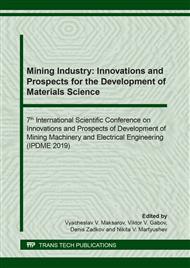[1]
V. Maksarov, Cutting process simulation on the basis of Rheological properties, 26th DAAAM Int. symp. on intelligent manufacturing and automation, p.229–237, (2016).
DOI: 10.2507/26th.daaam.proceedings.032
Google Scholar
[2]
J. Olt, O. Liivapuu, V. Maksarov et al., Mathematical modelling of cutting process system, Springer Proceedings in Mathematics and Statistics 178 (2016) 173–186.
DOI: 10.1007/978-3-319-42082-0_11
Google Scholar
[3]
A.G. Grigoriants, I.N. Shiganov, A.I. Misyurov, Technological processes of laser processing, BMSTU, Moskow, 2006, 664 p.
Google Scholar
[4]
J. Olt, V. Maksarov, Development of chatter-resistant system of cutting tool, Annals of DAAAM and Proc. of the 26th Int. DAAAM Symp. Proceedings of the 26th DAAAM Int. Symp., DAAAM 2015,, p.223–228, (2015).
DOI: 10.2507/26th.daaam.proceedings.031
Google Scholar
[5]
V. Maksarov, A. Khalimonenko, D. Timofeev, Machining quality when lathing blanks with ceramic cutting tools, Agronomy Res. 12(1) (2014) 269–278.
Google Scholar
[6]
M.E. Elyasberg, Self-oscillations of metal cutting machines: theory and practice, OKBS, St. Petersburg, (1993).
Google Scholar
[7]
V. Maksarov, J. Olt, Dynamic stabilization of machining process based on local metastability in controlled robotic systems of CNC machines, J. of Mining Instit. 226 (2017) 446–451.
Google Scholar
[8]
V.F. Bezyazychnyi, M. Szcerek, M.L. Pervov et al., The Study of the Effect of Temperature on the Ability of Metals to Accumulate Energy During Their Plastic Deformation, J. of Mining Instit. 235 (2019) 55–59.
Google Scholar
[9]
D. Vasilkov, A Nikitin, V. Cherdakova, Dynamic System Stability when Machining with Cutter, IOP Conf. Ser. Earth and Environmental Sci. 194 (2018) 022045.
DOI: 10.1088/1755-1315/194/2/022045
Google Scholar
[10]
V.F. Bevza, V.P. Grusha, V.A. Krasnyi, Use of directional solidification for improving tubular workpiece quality of different cast irons, Metallurgist 62(5-6) (2018) 521–531.
DOI: 10.1007/s11015-018-0689-8
Google Scholar
[11]
V.A. Krasnyy, A.Yu. Vazhenin, The Assessment of Wear Resistance of Thin-Layer Carbide Coatings under Vacuum Arc Depositio. Advances in Engineering Research, vol. 177, p.213–217, 2018. Proc. of the Int. Symp. Engineering and Earth Sciences: Applied and Fundamental Research, (ISEES 2018).
DOI: 10.2991/isees-18.2018.41
Google Scholar
[12]
E.B. Sedakova, Y.P. Kozyrev, Influence of Particle Size on the Wear Resistance and Strength of Polymer Composites, Russ. Engineer. Res. 38(7) (2018) 513–516.
DOI: 10.3103/s1068798x1807016x
Google Scholar
[13]
A.M. Schipachev, Optimum Conditionsof Turning and Surface Plastic Defomation DeterminationTaking into Account Technological Heredity, J. of Phys.: Conf. Ser. 1118, (2018). DOI :10.1088/1742-6596/1118/1/012036.
DOI: 10.1088/1742-6596/1118/1/012036
Google Scholar
[14]
L.K. Nguyen, D.A. Zadkov, V.V. Gabov, Improvement of drum shearer coal loading performance, Eurasian Mining 2 (2018) 22–25.
DOI: 10.17580/em.2018.02.06
Google Scholar
[15]
A.R. Mavliutov, E.G. Zlotnikov, Optimization of cutting parameters for machining time in turning process, IOP Conf. Ser. Mater. Sci. and Engineer. 327 (2018) 42069.
DOI: 10.1088/1757-899x/327/4/042069
Google Scholar
[16]
V.Yu. Skeeba, V.V. Ivancivsky, N.V. Martyushev et al., Numerical simulation of temperature field in steel under action of electron beam heating Source, Key Engineer. Mater. 712 (2016) 105–111.
DOI: 10.4028/www.scientific.net/kem.712.105
Google Scholar


